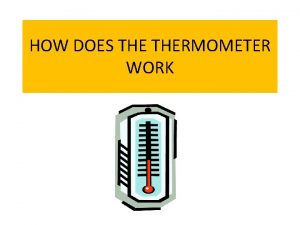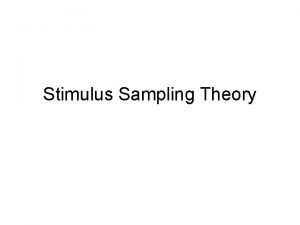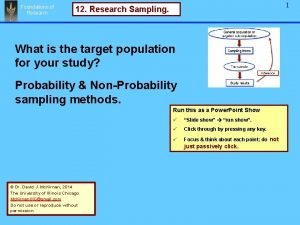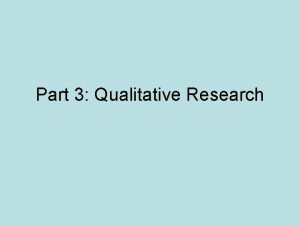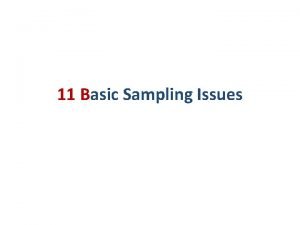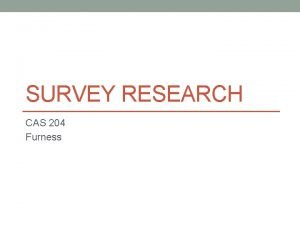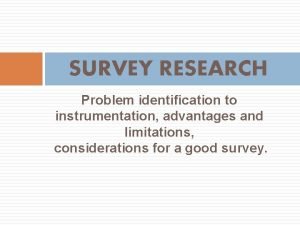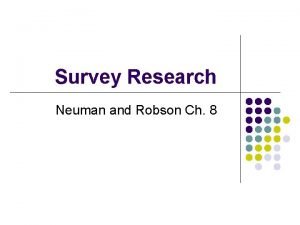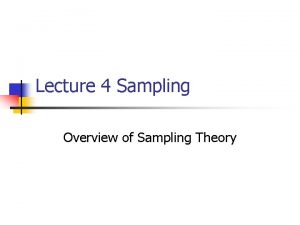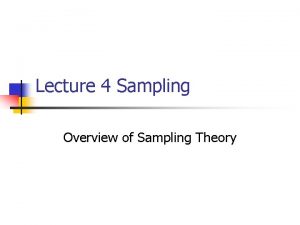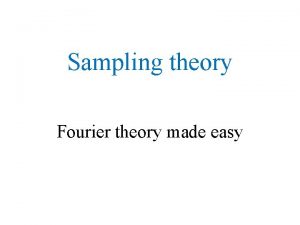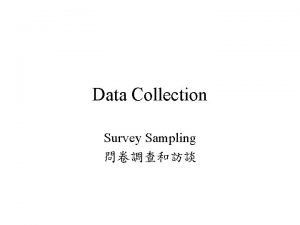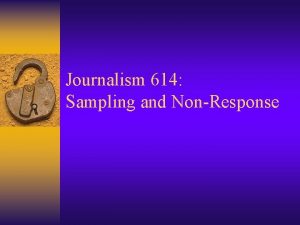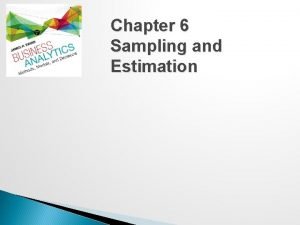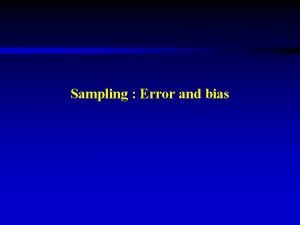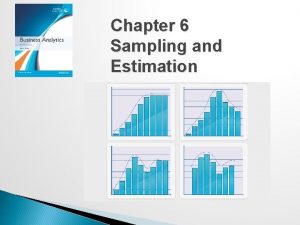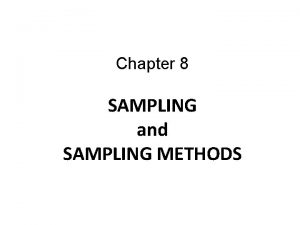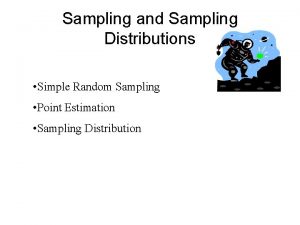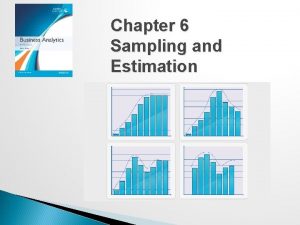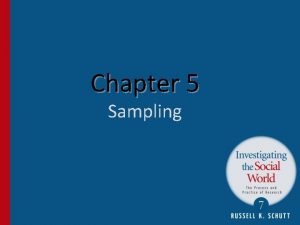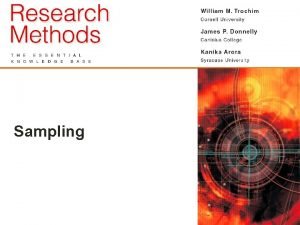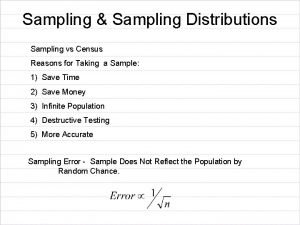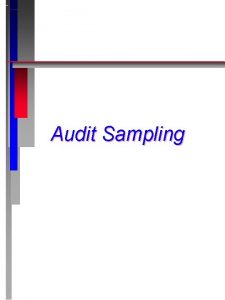Survey Research and Sampling Theory Survey research relies




























- Slides: 28

Survey Research and Sampling Theory • Survey research: relies primarily on probability sampling • Uses findings from a smaller sample to generalize to a larger target population • Focus on sampling theory

Sampling Theory ØDescriptive: describing attributes of particular sample ØInferential: generalizing beyond sample to larger population

What is sampling? Ø Process of selecting subset of observations from among many possible observations to draw conclusions about a larger population Ø Representativeness: each individual in larger population has an equal chance of being chosen for sample

Benefits of sampling 1) Sample is representative 2) Ability to calculate accuracy of sample (standard error)

9 Definitions 1) 2) 3) 4) 5) Population: target population Study population: population used for study Sampling unit: units used for selection Sampling frame: list of sampling units used Observation unit: person from which data are collected 6) Binomial variable: variable with two responses

9 definitions 7) Statistic vs. parameter: summary description of variable in a sample vs. summary description in target population 8) Sampling error (s. e. ): determines accuracy of sample 9) Confidence levels: way of expressing degrees of confidence

Statistic vs. parameter Sample Statistic Population Parameter Mean _ X (mu) Standard deviation s σ (sigma)

Standard error s. e. = proportion saying yes q = proportion saying no (1 -p) n = sample size pxq n

Standard error 99. 9%

Standard error s. e. = . 70 x. 30 1000

Standard error s. e. = . 21 1000 s. e. =. 01449 s. e. = 1. 449, or 1. 4% (. 1 decimal place)

Standard error 70. 0

Properties of standard errors: different values of p’s and q’s p 0. 0. 20. 40. 50. 60. 80 1. 0 q 1. 0. 80. 60. 50. 40. 20 0. 0 n 100 100 s. e. 0. 0. 049. 05. 049. 04 0. 0

Properties of standard errors: different sample sizes n 50 100 150 200 250 1000 p. 5. 5. 5 q. 5. 5. 5 s. e. . 07. 05. 04. 035. 032. 016

Examples: Roper Public Opinion Survey p q n s. e. CNN (10/13 -15/06) . 36 . 64 1012 1. 5% ABC (10/8/01) . 92 . 08 1009 . 85% Gallup (8/16/01) . 57 . 43 1013 1. 6% p=approve of Pres. Bush, q=do not approve/no opinion

Probability sampling designs 1) Simple random sample (SRS): --decide on sampling frame --give number to everyone on list --use table of random numbers to choose people

Table of Random Numbers Source: http: //www. irs. ustreas. gov/prod/bus_info/tax_pro/irm-part/part 03/34740020. GIF

Probability sampling designs 2) Systematic sample with a random start: --simpler than SRS --choose every kth element, where k = # in population / # in sample (sampling interval)

Example: systematic sampling üTarget population = 1000 üSample population = 100 ük = 1000/100 ük = 10

Example: systematic sampling ük = 10 üStart randomly with number between 1 and k üRandomly select 6, then: 16, 26, 36. . . through 996 üWatch out for periodicity!

Periodicity Platoon 1 Platoon 2 Platoon 3 Platoon 4 Sgt. Corporal Corporal Private Private Private Private Private Private Private

Probability sampling designs 3) Stratified sample --ensures different groups are adequately represented in sample --increases accuracy in estimating population parameter --reduces s. e.

Example: stratified sample population % sample n Anglo 70% 70 Black 20% 20 Hispanics 10% 10 Total 100% 100

Probability sampling designs 4) Multistage cluster sample: --used when there is no list of names --create a sampling frame via set of “stages”

Multistage cluster sampling: 3 stages 1) Stage 1: define area using map (divided into blocks) --Choose blocks via SRS or systematic sampling --Blocks = PSU (primary sampling unit)

Multistage cluster sampling: 3 stages 2) Stage 2: list and number all dwelling on selected blocks only --SRS or systematic sampling of dwellings --Dwellings = secondary sampling unit

Multistage cluster sampling: 3 stages 3) Stage 3: --interview HH or randomly selected member of dwelling

Multistage cluster sampling: Implications ü Sampling error increased: --Each sampling unit increases sampling error ü General guideline: maximize number of clusters and minimize number of elements within cluster ü Why?
 Probability vs non probability sampling
Probability vs non probability sampling Convenience sampling example situation
Convenience sampling example situation Multi-stage sampling example
Multi-stage sampling example Contoh laporan event sampling
Contoh laporan event sampling Stratified sample vs cluster sample
Stratified sample vs cluster sample Sampling definition
Sampling definition Natural sampling vs flat top sampling
Natural sampling vs flat top sampling What is feminist criticism
What is feminist criticism How does a bimetallic strip thermometer work
How does a bimetallic strip thermometer work An economic system that relies on habit custom or ritual
An economic system that relies on habit custom or ritual Standardization of outputs
Standardization of outputs Recovery equipment that relies upon the compressor
Recovery equipment that relies upon the compressor What is the sample size in qualitative research?
What is the sample size in qualitative research? 叫叫 abcd
叫叫 abcd Stimulus sampling theory
Stimulus sampling theory Basics of sampling
Basics of sampling Convenience sampling example situation
Convenience sampling example situation Sample frame example
Sample frame example Sampling in qualitative research
Sampling in qualitative research Quita sampling
Quita sampling Purposive sampling
Purposive sampling Sampling techniques in qualitative research
Sampling techniques in qualitative research Semantic differential scale advantages and disadvantages
Semantic differential scale advantages and disadvantages What is a survey research method
What is a survey research method Advantages of survey research
Advantages of survey research What is survey research
What is survey research Descriptive in research
Descriptive in research Advantage and disadvantage of observation method
Advantage and disadvantage of observation method Advantages of survey research
Advantages of survey research








